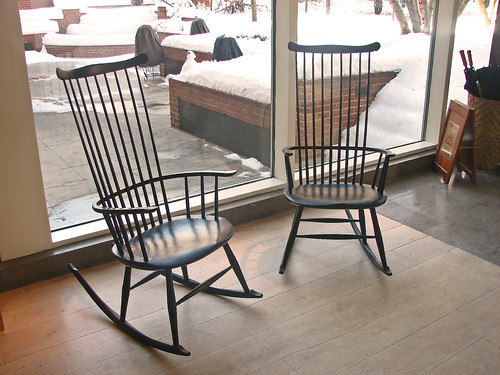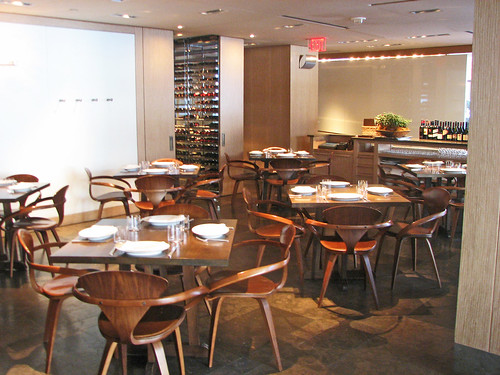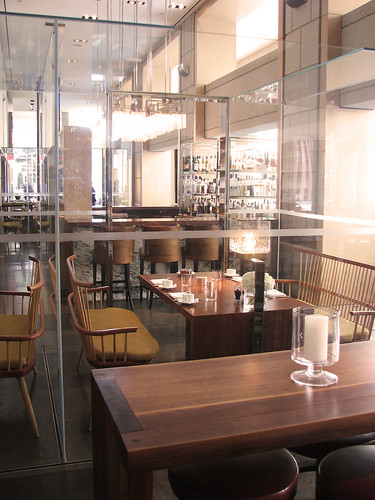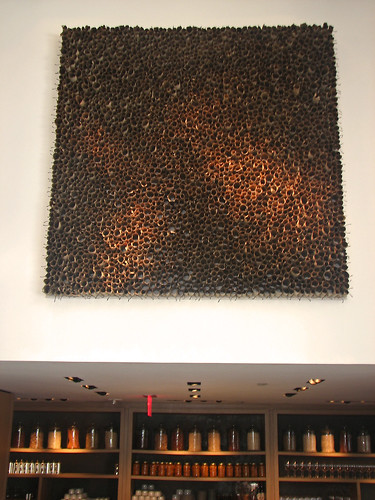
‘Rocking Chairs – Blue Duck Tavern’
courtesy of ‘prettylovelythings’
Author’s Note: So often we move through space too quickly – trying to get from one place to the next, without ever taking the time to stop and look around. Behind the Design is a new series that hopes to encourage an appreciation for the places we forget to take a moment and truly experience.
Located in the West End and tucked within the Park Hyatt, Blue Duck Tavern has become a staple among the DC foodie scene. With a farm-to-table menu that includes a variety of delights – even worthy of a Presidential date night, Blue Duck Tavern deems to be deserving of all its food-related accolades. However, often taking a back seat to the well-deserving menu is the other half of this award-winning duo: Blue Duck Tavern’s interior.
Designed in 2006 by Tony Chi and Associates of New York, Blue Duck Tavern demonstrates how an edited eye can fuse modern and traditional influences with an ease that can only be achieved by the very best of the industry – a vast improvement in comparison to the design of its predecessor, remembered as having resembled an “80’s-era airport lounge”. Material selection seemed to be the most prominent way of achieving Chi’s design intent of creating a space that would “bring together a dynamic and attractive modernism with classic American style”. The use of glass, stainless steel, and concrete against white oak, limestone, and burlap throughout the interior provided the juxtaposition needed to see his vision through.

‘Dining Room – Blue Duck Tavern’
courtesy of ‘prettylovelythings’
One can enter the Tavern through its main entrance, flanked by two-black lacquer ‘Georgetown colonial-style’ doors that measure 16 feet high – or through the Park Hyatt’s unique Tea Cellar; both paying homage to the city’s political and historical beginnings. The Tea Cellar, the first of its kind in the District, stores specialty teas, such as the popular Blood Orange and sweet Rooibos (fields of France), in floor-to-ceiling Pu-Erh swivel displays made of wood, nickel, and glass. Equally impressive in the Tea Cellar is the central location of a white and black marble tea table that is utilized to host afternoon tea and evening wine pairings.
The open floor plan of the Tavern maximizes the natural sunlight that pours through the space’s floor-to-ceiling windows, but created a challenge for the design team – one that required a solution that would present a space that felt both warm and comfortable while remaining spacious and contemporary. Playing with scale was the answer to the design predicament, and has since become one of the the Tavern’s most unique features. Glass enclosed, elevated, and soundproof “Capitol Hill Style” booths provide intimate niches within the larger context, and are wildly popular among celebrities and political figures who love to be seen, yet, not heard. The use of glass is visible throughout the Tavern as a medium to break-up scale while still encouraging inclusion.

‘Privacy Booths – Blue Duck Tavern’
courtesy of ‘prettylovelythings’
Continuing to drive the Tavern’s ambiance is the open pastry-poultry pantry and kitchen, giving diners the opportunity to feel involved in the dining process beyond the knife and fork (which are made by Hepp in case you were wondering). Additionally unique within the kitchen area is the the custom cobalt lacquer Molteni range, with the Tavern being the first commercial property in Washington to house this coveted French cook-top.
The Main Dining Room is L-shaped with a featured Timothy Clark Windsor bench measuring 29′ long serving as the perimeter enclosure. Clark, a cabinetmaker and chairwright from Vermont, also hand crafted all of the rocking chairs dispersed among the furnishings. Furthermore, all of the tables throughout the Tavern are made of solid walnut and are accompanied by modern-twisted log dining chairs.

‘Chef’s Table – Blue Duck Tavern’
courtesy of ‘prettylovelythings’
Four wine cellars that are made of glass and steel help to divide the Main Dining Room from the private Chef’s Table. The Private Dining Room, which seats 16 to 18 guests, is framed by an indigo burlap wall – representing the ‘blue’ in the American Flag (the red burlap and white columns are located in the Hotel Lobby), and the extra-long hand crafted dining table perfectly suits the special 5-course family style menu served. Since the Tavern is all about promoting the use of seasonal ingredients within their menu, it is not surprising that there is also a 42-seat outdoor terrace enclosed by a garden that harvests fresh herbs, vegetables, and fruits that are then incorporated into specials developed by Executive Chef Brian McBride and Chef de Cuisine Michael Santoro.

‘Jae Hyo Lee – Blue Duck Tavern’
courtesy of ‘prettylovelythings’
Artwork by Jae-Hyo Lee from Korea (such as the burnt wood and nail sculpture located across from the Tavern’s main entrance) and New York-based Japanese artist Kuzaya Morimoto help to serve as distinctive accessories to the overall design aesthetic. Rounding out a design that in my opinion is both visually pleasing and characteristically welcoming.
Blue Duck Tavern is located within the Park Hyatt Washington on the corner of 24th and M Streets, NW.
Great feature!I’d love a description of the design detail behind Corduroy.
I visited the bar there during the blizzard and loved it. Awesome atmosphere, comfortable seats, great hot drinks!
We went there for Thanksgiving last year; it’s nice to read a bit the design and decor.
Great feature! Really looking forward to reading more.
Pingback: uberVU - social comments
Great article! I have only been there for dinner, but I’d like to try Blue Duck’s brunch.
Pingback: Behind the Design: National Press Club » We Love DC